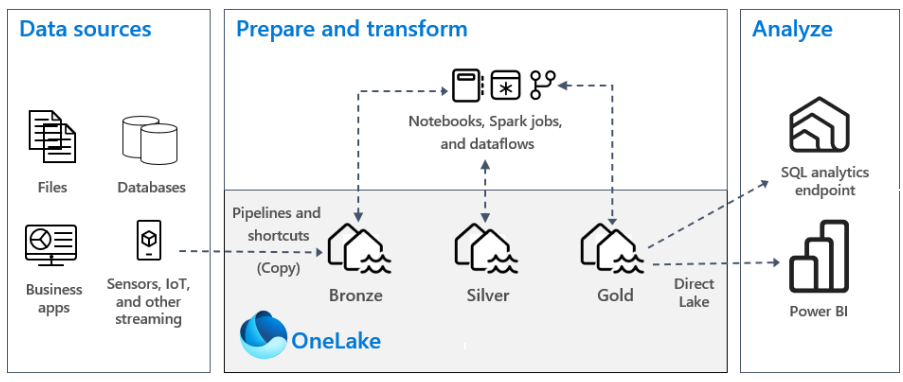In the dynamic realm of data management, Microsoft Fabric emerges as a comprehensive solution, offering a unified platform for analytics and machine learning at scale. At the core of this innovation are OneLake and the Lakehouse, shaping a new era in data consolidation and analysis.
This blog provides a concise exploration of the distinctions between OneLake, the centralized data repository, and the Lakehouse, a logical construct built for unified data management.
OneLake – Foundation of Microsoft Fabric
OneLake is the engine that drives Microsoft Fabric, acting as a central hub where all your organization’s data smoothly comes together. In the world of Microsoft, it’s often referred to as “OneDrive for Data”. This unique platform is constructed on Azure Data Lake Storage Gen2 and can handle different types of data, creating a unified and organized data lake. It streamlines how data is managed, making collaboration and governance easier. With tools like workspaces, data items, and shortcuts, OneLake makes working with data simple, encourages teamwork, and makes analytics tasks incredibly straightforward.

Source: Microsoft learn
Lakehouse – Elevating Data Management.
A Lakehouse, within the OneLake platform, is a comprehensive solution designed for storing, managing, and analyzing both structured and unstructured data in a unified repository. Lakehouse elevates data management by unifying the strengths of data lakes and warehouses into a single, versatile platform Leveraging Delta Lake as the standard file format for tabular data, it supports essential features like ACID transactions, schema evolution, and rapid data reads. OneLake allows the creation of multiple lakehouses, accessible through diverse analytical engines such as Spark, SQL, and Databricks.

Source: Microsoft learn
Key Distinctions Between OneLake and Lakehouse
Nature
- OneLake: Data store.
- Lakehouse: Data platform.
Unified Data Storage
- OneLake is the centralized repository for all analytics data.
- A lakehouse, as a logical construct, extends the capabilities of OneLake by providing a unified platform for data management and analysis.
Data Format
- OneLake: Standardized on Delta Lake format for tabular data.
- Lakehouse: Flexible, supports any data format and type.
Flexibility and Accessibility
- OneLake supports all data formats and types, ensuring flexibility in handling diverse datasets.
- Lakehouse allows you to work with your data in a unified and flexible way, using various tools and services to ingest, transform, and analyse your data, such as Azure Data Factory, Azure Databricks, Azure Synapse Analytics, Azure Machine Learning, etc
Schema, Security, and Governance
- Multiple lakehouse can be created within OneLake, each customizable with its schema, security, and governance policies.
- This flexibility allows organizations to tailor their data management approach based on specific needs and requirements.
Analytical Capabilities
- OneLake forms the backbone for analytics data storage.
- A lakehouse, with its SQL analytics endpoint and compatibility with Power BI reports via DirectLake, empowers organizations to conduct in-depth analyses with ease.
Data Storage
- OneLake: Centralized repository for all analytics data.
- Lakehouse: A logical construct built on OneLake for unified data storage, management, and analysis.
Scalability
- OneLake: Limited to a single instance per Microsoft Fabric subscription.
- Lakehouse: Offers scalability with the ability to create multiple instances within OneLake. Each instance can have unique schema, security, and governance policies, allowing for tailored configurations based on specific needs.
Access and Analysis
- OneLake: Standardized Delta Lake format for efficient tabular data handling.
- Lakehouse: Offers SQL analytics endpoint and integrates with Power BI for in-depth data analysis.
Real-Time Capabilities
- OneLake: Supports real-time analytics.
- Lakehouse: Facilitates operational analytics and long-term analysis on the same dataset.
Integration
- OneLake: Part of Microsoft Fabric’s comprehensive data platform.
- Lakehouse: Works seamlessly with OneLake, creating a cohesive environment for data exploration.
Administrative Control
- OneLake: Governed by a single instance at the Microsoft Fabric subscription level.
- Lakehouse: Provides more administrative control with the option to create and manage multiple instances independently. Each instance can have distinct governance policies, enhancing flexibility in data management.
Role in Data Management
- OneLake: Acts as a centralized repository, serving as the foundation for storing all analytics data.
- Lakehouse: Plays a pivotal role in data projects by providing a single view tailored for each specific project’s needs. Enables comprehensive storage, management, and analysis within a unified platform, optimizing the workflow for individual data initiatives.
| Tags | Microsoft Fabric |
| Useful links |
|
| MS Learn Modules | |
Test Your Knowledge |
Quiz |
